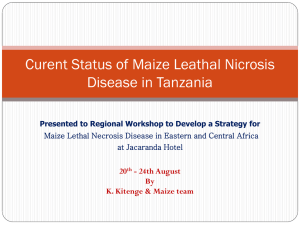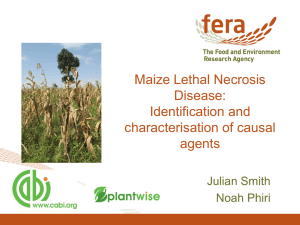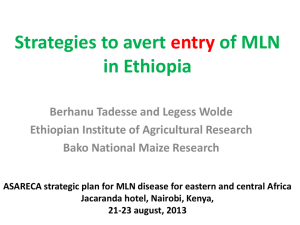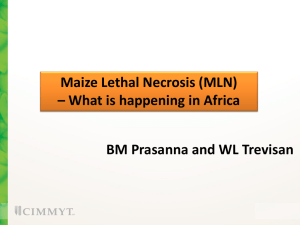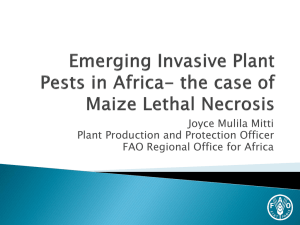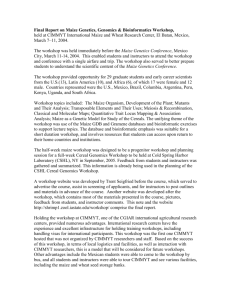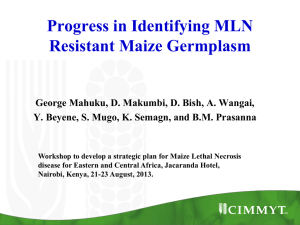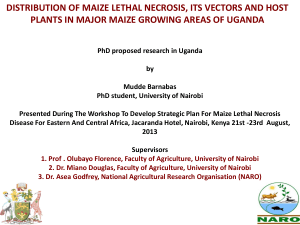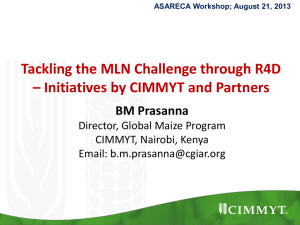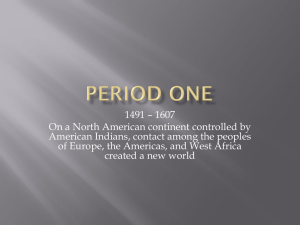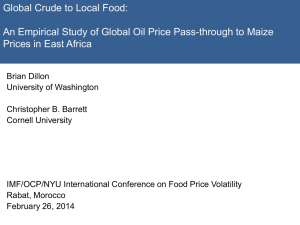Dr Anne Wangai
advertisement
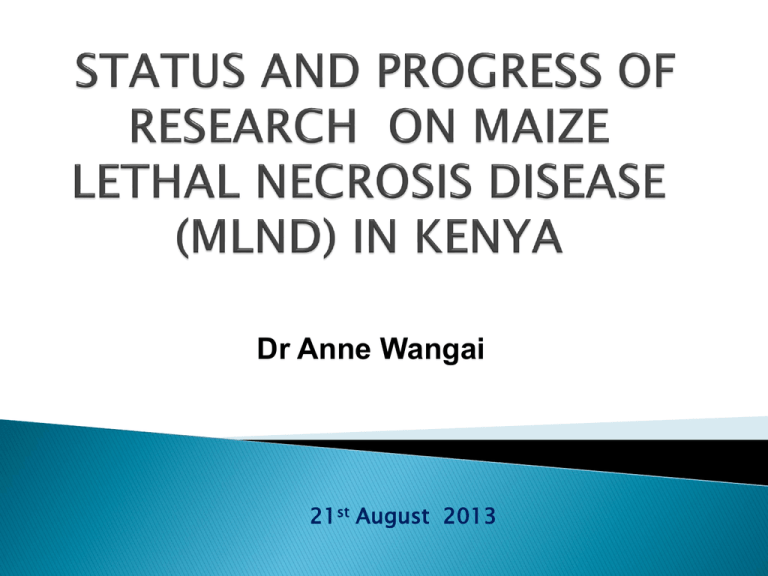
Dr Anne Wangai 21st August 2013 MLN TEAM COLLABORATORS Ministry of Agriculture KARI KEPHIS PCPB UON CIMMYT ICIPE STAK CGA AAK Government Organizations International Organizations Private Organizations OARDC- Ohio State University , USA University of Minnesota, USA CABI Food and Environment Research Agency (FERA), UK 1.Introduction 2.What has been done 3.Observations 4.Recommendations Farmers in Bomet call it, ‘Koroito’ - the vernacular name for a plague A sudden phenomenon that could not be explained, Cause unknown, Having a devastating effect to the community. September 2011, disease first reported in the lower parts of Longisa division of Bomet District. February 2012, noted in Bomet Central division, spreading into neighbouring Chepalungu District, Narok North & South Districts, Naivasha April 2012, Disease spread into Sotik,, Koinon, Transmara, Rumuruti, Kisii, Bureti, Kericho, Mathira East, Imenti South and Embu. Field observations revealed that the disease is affecting all maize varieties grown in these regions, Estimated yield loss in affected fields ranged from 30-100% ◦ Contaminated seeds from agro vet shops ◦ Government relief seeds ◦ Insects damage ◦ Frost damage ◦ Do not know the source ◦ God’s vengeance Maize Lethal Necrosis (MLN) Disease (Synonym; Corn Lethal Necrosis (CLN )Disease. Disease caused by co-infection with Maize chlorotic mottle viruses (MCMV) AND Sugarcane mosaic virus (SCMV) OR any other cereal virus in the Potyvirus group (eg. Maize mottle virus –MMV and Wheat streak virus-WSV ). Family: Potyviridae Genus: Potyvirus Species: Sugarcane mosaic virus Acronym: SCMV How is SCMV transmitted Mechanical Insects Aphids Seed transmission rates – very low rates SCMV = 21/72,897 plants ( 0.03 %) Family: Tombusviridae Genus: Machlomovirus Species: Maize chlorotic mottle virus Acronym: MCMV How is MCMV transmitted Mechanical Insects Corn thrips Cereal leaf beetle Seed transmission – v. low –MCMV = 17/42,000 & 1/22,189 seeds (0.04%, 0.005%) –MDMV = 21/72,897 plants (0.03%) Food and economic security threatened Losses for seed producers (for both growers and seed companies) Millers (both in quality and quantity) Transporters (reduced volume of business) Storage facilities (dormant capacity) Middlemen (loss of business volumes) MLND DISTRIBUTION -2012 ? ? ? % Relative areas reported affected by MLND nationally - July 2012 70 60 50 40 30 20 10 0 Rift Valley Eastern Central Nyanza Economic loss (M-Ksh) (Total US $ 67m) ) 4000 3500 3000 2500 2000 1500 1000 500 0 Economic loss (m-Ksh) Rift Valley 3762.5 Eastern 927.5 Regions Central 125.6 Nyanza 794.5 -Survey maize growing areas in May-June by KARI and Prof. Lockhart, University of Minnesota to Identify distribution of SCMV and MCMV Enhanced diagnostic testing for MLN at KARI Biotech Prof. Ben Lockhart with District crops officer Sotik 15 Counties surveyed: Narok Kisumu Bomet Nandi Nyamira Kericho Migori Nakuru Siaya Trans Nzoia Busia Baringo Kakamega Elgeyo Marakwet West Pokot 10 counties to be surveyed: Nyeri Embu Muranga Meru Machakos Kitui Kilifi Tana River Kwale Taita Taveta • Counties surveyed and disease severity: SEVERE-Narok, Bomet, Nyamira, West Pokot, Nandi MILD- Migori, Siaya, Busia, Kakamega, Kisumu,, Kericho, Naivasha , Elgeyo Marakwet, Baringo. VERY LOW- Trans Nzoia (except West Pokot), Uasin Gishu, Nakuru • Over 2000 samples collected Screening of inbreed lines by (KARI, CIMMYT) KARI-CIMMYT team has evaluated over 2,000 maize genotypes in Narok and Naivasha elite inbreed , pre commercial hybrids, elite lines & pre-commercial hybrids, commercial hybrids Evaluated lines revealed ca. < 5% resistance/moderate Establishing a centralized MLN screening facility at KARI-Naivasha (In progress) Offer an opportunity for screening elite germplasm for KARI, CIMMYT as well as public and private partners in EA 1.2 ARTIFICIAL INOCULATION PROCESS Inoculum multiplication (SCMV & MCMV) Notes taking/ scoring Inoculum Preparation Artificial inoculation CIMMYT & NARS WORKSHOP –Two workshops Objectives: Raise awareness about MLN to scientist, technicians & skilled field staff Train MLN identification Train Scoring MLN MLN management Draft strategies to combat MLN KARI and MoA: Created public awareness on disease and management options to Extension staff, Stakeholders, Farmers via a) Electronic and Mass media b) Technical Publications c) Public Forums d) Field days e) Workshops for Extension Officers in 36 counties Creation of public awareness Conducting tests to verify seed transmission of viruses in local cultivars Host Resistance: Intensify screening of maize germplasm for tolerance/resistance to MLND Initiate MLND tolerance/resistance breeding in maize improvement programs ……Recommendations Review cropping practices Vector management Integrated Pest Management options Identifying alternate hosts of viruses and vectors Introduction of closed maize seasons, Quarantine movement, removal and disposal of infected maize crop, Crop Rotation Schedules Commend regime of pesticide applications for vector control (seed and foliar) Genetic resistance, Vector control, Cultural, Good Agricultural Practices Strategic research for tolerance/resistance Capacity building along value chain for disease and pest management Establish a system for pest and disease forecasting & early warning Establish a centralized data bank and backup system Formulate and implement conducive policies on handling of emerging pest and disease epidemics Principal Secretary, Ministry of Agriculture Director, KARI
